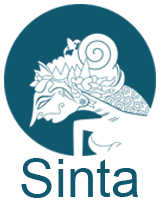Application of various statistical approaches for sensory evaluation of seaweed dodol mixed agarwood infusion
Abstract
Seaweed dodol mixed agarwood infusion is an innovative culinary product from Lombok Island made primarily from seaweed flour. This research aims to conduct a sensory evaluation of seaweed dodol mixed agarwood infusion using the 9-point hedonic scale with different statistical approaches for the analysis. Four different seaweed concentrations were applied in this research as treatments: S1(seaweed flour 8% w/v), S2 (seaweed flour 10% w/v), S3 (seaweed flour 12% w/v), S4 (seaweed flour 14% w/v). The proximate analysis measures total protein, lipid, ash, water, and carbohydrates. This study used a Nine-point hedonic scale ranging from 9 (like extremely) to 1 (disklike extremely). Non-parametric statistics (Kruskal-Wallis and Freidman Test) and parametric statistics (ANOVA-CRD and ANOVA-RCBD) are the statistical approaches in this study, which are continued by DMRT (α = 0.05). Thirty trained respondents were evaluated based on appearance, aroma, taste, and texture. Proximate analysis shows that dodol has high moisture with medium carbohydrate content. The result shows that different statistical approaches have a consistent critical P-value, which shows the highly significant effect of treatment on the sensory evaluation value. DMRT analysis shows that the higher seaweed flour concentration results in a higher numerical hedonic value. The spider web chart shows respondents give a more sensitive evaluation of taste and texture than appearance and aroma. It could be concluded that different statistical approaches are reliable for analysing the significant effect of different seaweed flour concentrations on the sensory evaluation value of seaweed dodol mixed agarwood infusion.
Keywords
Full Text:
PDFReferences
Abdani, I. M. (2013). Evaluasi Sensori Konsumen Pada Dodol Rumput Laut (Eucheuma cottoni) Dengan Penambahan Tepung Kanji dan Tepung Ketan. Jurnal Harpodon Borneo, 6(1), 43–48. http://180.250.193.171/index.php/harpodon/article/view/103%0Ahttp://180.250.193.171/index.php/harpodon/article/download/103/91
Aini, H., Kurnia, N., & Wangiyana, I. G. A. S. (2024). Sensory evaluation of lemongrass beverage mixed with agarwood infusion using 9-point hedonic scale. Jurnal Silva Samalas, 7(2), 28–35. https://doi.org/10.33394/jss.v7i2.14298
Andjani, J. T., Maldino, F. M., Irhami, M. S., Nurhayati, Alpian, R., & Raksun, A. (2021). Pengemasan dan Pemasaran Produk Dodol Rumput Laut sebagai Olahan Pangan Sehat di Desa Seriwe Kecamatan Jerowaru Kabupaten Lombok Timur. Jurnal Pengabdian Magister Pendidikan IPA, 5(2), 85–88. https://doi.org/10.29303/jpmpi.v5i2.1635
Andrade, C. (2019). The P value and statistical significance: misunderstandings, explanations, challenges, and alternatives. Indian Journal of Psychological Medicine, 41(3), 210–215.
Asfan, Maflahah, I., & Farida, D. (2017). Analisis Tingkat Kesukaan Konsumen Ikan Asap Dengan Pelapisan Edible Coating dari Keragenan. Prosising Seminar Nasional Kelautan Dan Perikanan III, September, 230–238.
Asmare, E., & Begashaw, A. (2018). Review on Parametric and Nonparametric Methods of Efficiency Analysis. Open Acces Biostatistics and Bioinformatics, 2(2), 1–7. https://doi.org/10.31031/OABB.2018.02.000534
Baharudin, B., Triandini, I. G. A. A. H., & Wangiyana, I. G. A. S. (2023). Hedonic test of Lombok Island palm sugar candy formulated with Multi-Purpose Tree Species (MPTS) leaves infusion. Journal of Agritechnology and Food Processing, 3(2), 92–100.
Cichero, J. A. Y. (2020). Evaluating chewing function: Expanding the dysphagia field using food oral processing and the IDDSI framework. In Journal of Texture Studies (Vol. 51, Issue 1, pp. 56–66). Blackwell Publishing Ltd. https://doi.org/10.1111/jtxs.12462
Citrawati, G. A., & Pratama, S. (2024). Uji Hedonik Bakso terhadap Campuran Bumbu pada Daging melalui Analisis Pendekatan Statistik di Wilayah Perbatasan Republik Indonesia - Republik Demokratik Timor Leste. Jurnal Triton, 15(1), 200–206. https://doi.org/10.47687/jt.v15i1.491
Ebbeling, C. B., Feldman, H. A., Klein, G. L., Wong, J. M. W., Bielak, L., Steltz, S. K., Luoto, P. K., Wolfe, R. R., Wong, W. W., & Ludwig, D. S. (2018). Effects of a low carbohydrate diet on energy expenditure during weight loss maintenance: randomized trial. BMJ, 363, k4583. https://doi.org/10.1136/bmj.k4583
Eden, W. T., & Rumambarsari, C. O. (2020). Proximate analysis of soybean and red beans cookies according to the Indonesian National Standard. Journal of Physics: Conference Series, 1567(022033), 1–5. https://doi.org/10.1088/1742-6596/1567/2/022033
Elfahira, D. R., Hudi, L., & Nurbaya, S. R. (2022). The Effect of Gracilaria verrucosa Seaweed Flour Proportion with White Glutinous Rice Flour (Oryza sativa Glutinosa) and CMC (Carboxy Methyl Cellulose) Concentration on Physical and Chemical Characteristics of Seaweed Dodol. Procedia of Engineering and Life Science, 3, 1–7. https://doi.org/10.21070/pels.v3i1.1304
Fajriyah, S. N., & Oktafa, H. (2020). Studi Pembuatan Puding Kombinasi Belimbing Wuluh dan Jambu Biji Merah Sebagai Alternatif Makanan Selingan Sumber Antioksidan. HARENA: Jurnal Gizi, 1(1), 41–55.
Karina, I., & Desrizal. (2021). Evaluasi mutu dodol dengan penambahan rumput laut cokelat (Sargassum sp.) sebagai makanan olahan sehat. Teknologi Pangan : Media Informasi Dan Komunikasi Ilmiah Teknologi Pertanian, 12(2), 220–230. https://doi.org/10.35891/tp.v12i2.2465
Kayali, Z., Obaydo, R. H., & Sakur, A. A. (2023). Spider diagram and sustainability evaluation of UV-methods strategy for quantification of aspirin and sildenafil citrate in the presence of salicylic acid in their bulk and formulation. Heliyon, 9(4), e15260.
Lee, W.-K., Lim, Y.-Y., Leow, A. T.-C., Namasivayam, P., Abdullah, J. O., & Ho, C.-L. (2017). Factors affecting yield and gelling properties of agar. Journal of Applied Phycology, 29(3), 1527–1540. https://doi.org/10.1007/s10811-016-1009-y
Lukito, M. S., Giyarto, & Jayus. (2017). Sifat Fisik, Kimia Dan Organoleptik Dodol Hasil Variasi Rasio Tomat Dan Tepung Rumput Laut. Jurnal Agroteknologi, 11(1), 82–95. https://doi.org/10.19184/j-agt.v11i1.5450
Lukito, M. W., Giyarto, & Jayus. (2017). Sifak Fisik, Kimia dan Organoleptik Dodol Hasil Variasi Rasio Tomat dan Tepung Rumput Laut. Jurnal Agroteknologi, 11(1), 82–95. https://jurnal.unej.ac.id/index.php/JAGT/article/view/5450
Mazur, J., Drabek, R., & Goldman, A. (2018). Hedonic contrast effects in multi-product food evaluations differing in complexity. Food Quality and Preference, 63(June 2016), 159–167. https://doi.org/10.1016/j.foodqual.2017.06.016
Moschopoulou, E., Moatsou, G., Syrokou, M. K., Paramithiotis, S., & Drosinos, E. H. (2019). Food quality changes during shelf life (C. M. B. T.-F. Q. and S. L. Galanakis (ed.); pp. 1–31). Academic Press. https://doi.org/https://doi.org/10.1016/B978-0-12-817190-5.00001-X
Musrianti, M., & Hutasoit, J. P. (2023). The Effect of Addition of Green Okra (Albemoschus Esculentus) On Moisture Content and of Seaweed Dodol. Food and Agroindustry Journal, 4(2), 1–6. https://doi.org/10.36761/fagi.v4i2.3501
Nazaruddin, N., & Ansar, A. (2017). Pengolahan Dodol Rumput Laut Khas Lombok Nusa Tenggara Barat. Jurnal Abdi Insani, 4(2), 98–102. https://abdiinsani.unram.ac.id/index.php/jurnal/article/view/121
Park, S., Kim, D., Park, H., Yoon, D., & Byambaa, S. (2021). Improvement of chewing and swallowing risks in community-dwelling older adults using texture-modified food. Nutrition Research and Practice, 16(3), 354–365. https://doi.org/10.4162/nrp.2022.16.3.354
Parwata, A., Manuaba, P., & Yasa, S. (2018). The potency of flavonoid compounds in water extract Gyrinops versteegii leaves as natural antioxidants sources. Biomedical and Pharmacology Journal, 11(3), 1501–1511. https://doi.org/10.13005/bpj/1517
Pasaribu, H. U., Ali, A., & Hamzah, F. (2015). Pemanfaatan Mangga Arum Manis dalam Pembuatan Dodol dengan Perbedaan Konsentrasi Tepung Ketan dan Rumput Laut. Jurnal Online Mahasiswa Fakultas Pertanian Universitas Riau, 2(2), 1–15.
Prihantini, A. I., & Rizqiani, K. D. (2019). Various antioxidant assays of agarwood extracts (Gyrinops versteegii) from West Lombok, West Nusa Tenggara, Indonesia. Asian Journal of Agriculture, 3(1), 1–5. https://doi.org/10.13057/asianjagric/g03101
Puleo, S., Miele, N. A., Cavella, S., Masi, P., & Di Monaco, R. (2020). How sensory sensitivity to graininess could be measured? Journal of Texture Studies, 51(2), 242–251. https://doi.org/https://doi.org/10.1111/jtxs.12487
Purwanto, R. O., Argo, B. D., & Hermanto, M. B. (2013). Pengaruh Komposisi Sirup Glukosa Dan Variasi Suhu Pengeringan Terhadap Sifat Fisiko - Kimia Dan Inderawi Dodol Rumput Laut ( Eucheuma Spinosium ). Jurnal Bioproses Komoditas Tropis, 1(1), 1–12.
Rahmayuni, R., Dewi, Y. K., & Selfianti, D. (2023). Pemanfaatan Labu Kuning dan Rumput Laut dalam Pembuatan Dodol. AGRITEKNO: Jurnal Teknologi Pertanian, 12(2), 115–123. https://doi.org/10.30598/jagritekno.2023.12.2.115
Rhein-Knudsen, N., Ale, M. T., Ajalloueian, F., Yu, L., & Meyer, A. S. (2017). Rheological properties of agar and carrageenan from Ghanaian red seaweeds. Food Hydrocolloids, 63, 50–58. https://doi.org/https://doi.org/10.1016/j.foodhyd.2016.08.023
Setha, B., Arfah, H., & Pattipeilohy, F. (2019). Analisis Mutu Dodol Rumput Laut Eucheuma cottonii Dengan Penambahan Tepung Maizena dan Sari Buah Nenas. AGRITEKNO, Jurnal Teknologi Pertanian, 8(1), 14–23. https://doi.org/10.30598/jagritekno.2019.8.1.14
Shrestha, J. (2019). P-Value: A True Test of Significance in Agricultural Research. SSRN, October, 1–4. https://doi.org/http://dx.doi.org/10.2139/ssrn.4592804
Singawinata, I. P., Fachrul, B. F., Zakarias, R., & Fachrul, M. F. (2020). Pelatihan Kewirausahaan Pembuatan Dodol Rumput Laut Di Desa Kuta, Kecamatan Pujut - Mandalika Lombok Tengah, Nusa Tenggara Barat. JUARA: Jurnal Wahana Abdimas Sejahtera, 1(2), 206–216. https://doi.org/10.25105/juara.v1i2.7397
Sinurat, E., Fransiska, D., Utomo, B. S. B., Subaryono, S., & Nurhayati, N. (2024). Characteristics of powder agar extracted from different seaweeds species and locations in Indonesia. Journal of Applied Phycology, 36(2), 675–684. https://doi.org/10.1007/s10811-023-03084-y
Sirajuddin, S., Masni, M., & Salam, A. (2021). The level of preference of instant rice bran milk products innovation with various flavor variants as functional food. Open Access Macedonian Journal of Medical Sciences, 9(A), 567–571. https://doi.org/10.3889/oamjms.2021.6469
Świąder, K., & Marczewska, M. (2021). Trends of using sensory evaluation in new product development in the food industry in countries that belong to the EIT regional innovation scheme. Foods, 10(446), 1–18. https://doi.org/10.3390/foods10020446
Thangaraj, P. (2016). Proximate Composition Analysis. In Pharmacological Assays of Plant-Based Natural Products (pp. 21–31). Springer Cham.
Triandini, I. G. A. A. H., & Wangiyana, I. G. A. S. (2022). Mini-review uji hedonik pada produk teh herbal hutan. Jurnal Silva Samalas, 5(2), 12–19.
Triandini, I. G. A. A. H., Wiranto, & Wangiyana, I. G. A. S. (2024). Sensory evaluation of cookies formulated with rhizopora propagules flour using 9- point hedonic scale. Journal of Agritechnology and Food Processing, 4(2), 60–74.
Vitriasari, E., & Suyanto, A. (2012). Karakteristik Dodol Ubi Jalar Ungu (Ipomoea batatas blackie) dengan Variasi Penambahan Tepung Rumput Laut. Jurnal Pangan Dan Gizi, 3(6), 29–36. https://doi.org/10.26714/jpg.3.1.2012.
Wangiyana, I. G. A. S., Akram, & Isbulloh, F. (2020). Perbandingan Aktivitas Antibakteri Ekstrak Kasar Resin dan Daun Gaharu (Gyrinops versteegii). Jurnal Bioteknologi & Biosains Indonesia, 7(1), 28–36.
Wangiyana, I. G. A. S., Kurnia, N., Triandini, I. G. A. A. H., & Fatihatum. (2024). Sensory evaluation of palm sugar candy from Arenga sap water and agarwood leaves infusion using a 9-point hedonic scale. Jurnal Agrotek UMMAT, 11(2), 142–155.
Wangiyana, I. G. A. S., Kurnia, N., Triandini, I. G. A. A. H., & Lesmana, P. S. W. (2023). Food Sensory Respondent Training for Forestry Student of Universitas Pendidikan Mandalika Using Various Hedonic Scale. Sasambo: Journal of Community Service, 5(4), 827–834.
Wangiyana, I. G. A. S., Sawaludin, Nizar, W. Y., & Wangiyana, W. (2019). Tannin concentrations of Gyrinops tea with different leaf processing methods and addition of herbal medicine ingredients Tannin Concentrations of Gyrinops Tea with Different Leaf Processing Methods and Addition of Herbal Medicine Ingredients. AIP Conference Proceedings, 2199(070012), 1–7.
Wangiyana, I. G. A. S., Supriadi, Nikmatullah, A., Sunarpi, Putri, D. S., & Rosidah, S. (2021). Phytochemical screening and antioxidant activity of Gyrinops tea from agarwood plantation on Lombok island , Indonesia. IOP Conference Series: Earth and Environmental Science, 1–6. https://doi.org/10.1088/1755-1315/712/1/012029
Wangiyana, I. G. A. S., & Triandini, I. G. A. A. H. (2021). Mini-review Teknologi Produksi Teh Herbal Gaharu. Journal of Agritechnology and Food Processing, 1(2), 85–92.
Wangiyana, I. G. A. S., & Triandini, I. G. A. A. H. (2022). Hedonic test of tree leaf herbal tea using various statistical approaches. Journal of Agritechnology and Food Processing, 2(2), 43–53.
Wangiyana, I. G. A. S., Triandini, I. G. A. A. H., & Anita Nugraheni, Y. M. M. (2021). Hedonic test of agarwood tea from Gyrinops versteegii with different leaves processing method. Jurnal Riset Industri Hasil Hutan, 13(2), 99–110.
Wangiyana, I. G. A. S., Triandini, I. G. A. A. H., Putradi, D., & Wangiyana, W. (2018). Tannin Concentration of Gyrinops Tea from Leaves of Juvenile and Mature Agarwood Trees ( Gyrinops versteegii Gilg ( Domke )) with Different Processing Methods. Journal of Chemical and Pharmaceutical Research, 10(10), 113–119.
Warkoyo, Yuliarie Wulandari, N. H. (2018). Characterization of Edible Film from Starch of Taro (Colocasia esculenta (L.) Schott) with Addition of Chitosan on Dodol Substituted Seaweed (Eucheuma cottonii L.). Food Technology and Halal Science Journal, 1(1), 22–32. https://doi.org/10.22219/fths.v1i1.7544
Wattanapan, P., Saengnil, T., Niamnuy, C., Paphangkorakit, J., & Devahastin, S. (2021). Textural properties and muscle activities during mastication of normal and ultrasonically softened sticky rice aimed for consumers with swallowing disorder: A pilot study. Journal of Texture Studies, 52(5–6), 561–566. https://doi.org/10.1111/jtxs.12631
Wichchukit, S., & O’Mahony, M. (2015). The 9-point hedonic scale and hedonic ranking in food science: Some reappraisals and alternatives. Journal of the Science of Food and Agriculture, 95(11), 2167–2178. https://doi.org/10.1002/jsfa.6993
Wichchukit, S., & O’Mahony, M. (2022). The 9-point hedonic and unstructured line hedonic scales: An alternative analysis with more relevant effect sizes for preference. Food Quality and Preference, 99, 104575.
Widyatsih, T., & Jaya, F. M. (2017). Kajian mutu hedonik pempek Ceria dengan pewarna nabati. Jurnal Ilmu-Ilmu Perikanan Dan Budidaya Perairan, 12(2), 12–16.
Xia, Y., De Mingo, N., Martín, J. M., Bodeau, J., Perret, M., Zhong, F., & O’Mahony, M. (2021). Is the absolute scaling model the basis for the 9-point hedonic scale? Evidence from Poulton’s Stimulus Range Equalizing Bias. Food Quality and Preference, 89, 104153.
DOI: https://doi.org/10.31764/jafp.v5i1.30841
Refbacks
- There are currently no refbacks.
Copyright (c) 2025 I Gde Adi Suryawan Wangiyana, I Gusti Agung Ayu Hari Triandini, Idham Khalid

This work is licensed under a Creative Commons Attribution-ShareAlike 4.0 International License.
JAFP is indexing in the following databases:











